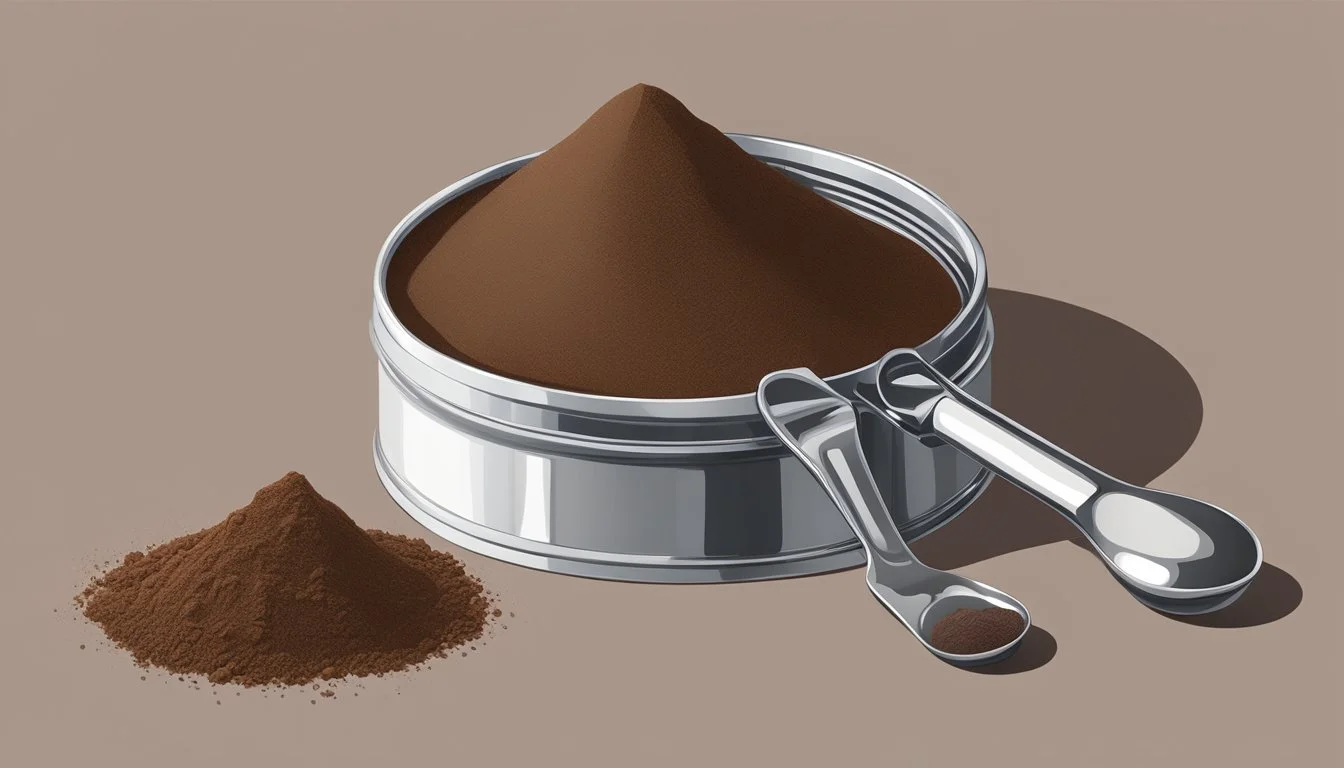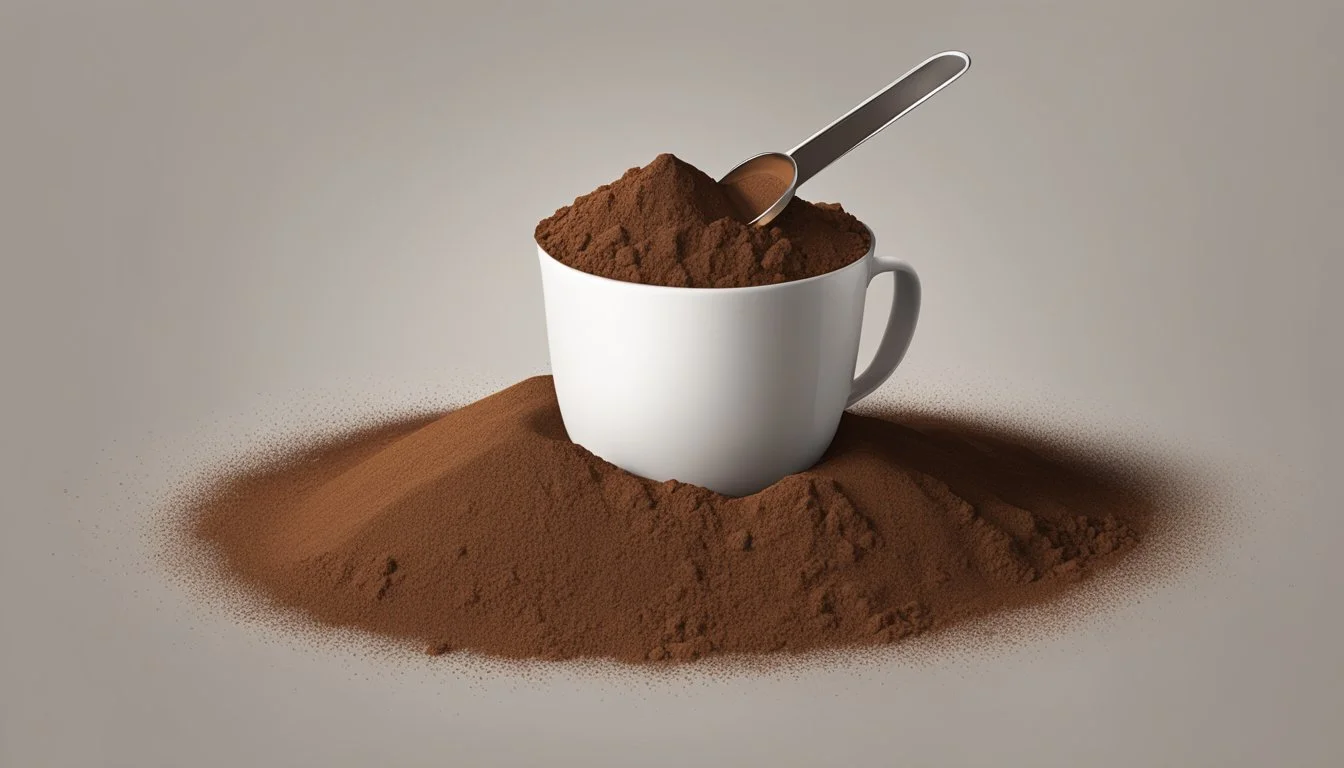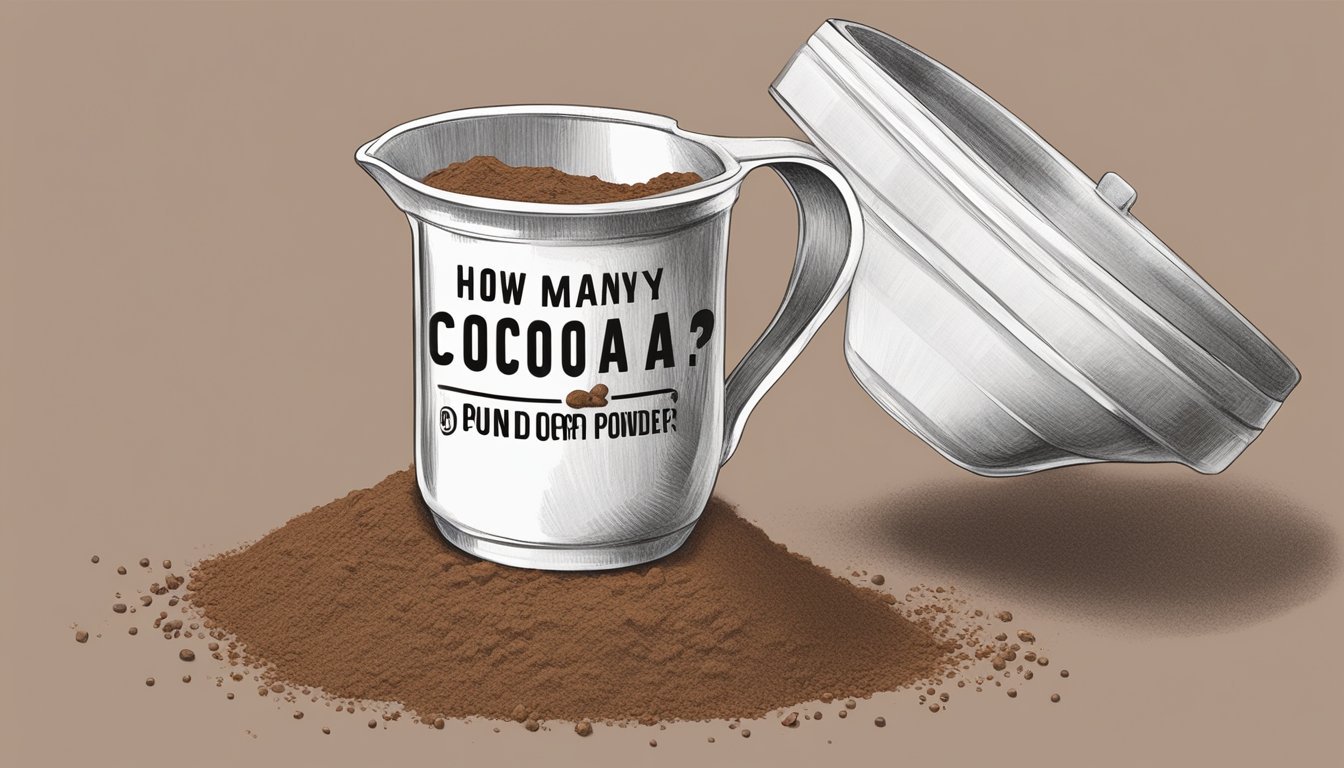How Many Tablespoons in a Pound of Cocoa Powder
Quick Measurement Guide
Determining the conversion of cocoa powder from pounds to tablespoons is a practical matter for both home cooks and professional chefs. Cocoa powder, known for its role in creating chocolate-flavored delicacies, is often measured by weight for accuracy, especially in recipes requiring precise proportions. A pound, being a standard unit of weight, equates to 16 ounces.
One pound of cocoa powder translates to approximately 60.5 tablespoons. This conversion is essential for those who prefer using volume measurements over weight, particularly when kitchen scales are not at hand. The precise number of tablespoons can vary slightly due to factors such as the cocoa powder's density and how tightly it's packed into the measuring spoon.
Understanding the relationship between weight and volume in cooking ingredients helps in achieving the desired outcome in baking and cooking. When dealing with cocoa powder, it is essential to handle measurements meticulously, as this ingredient can significantly impact the flavor and structure of the final product. Accurate conversion ensures that recipes are followed correctly, yielding consistent and desirable results.
Understanding Measurements in Baking
In baking, precise measurements ensure that recipes turn out consistently well. It's crucial to understand the difference between weight and volume, get familiar with units of measurement, and know which tools are appropriate for each type of measurement.
Weight vs Volume
In baking, one needs to distinguish between weight and volume to achieve accuracy. Weight measures an item's heaviness, and bakers typically use grams or ounces as units of mass. Volume, on the other hand, is the space an ingredient occupies, often referred to in cups, tablespoons, or teaspoons. For instance:
1 pound (lb) of cocoa powder converts to 3 cups, when using volume.
1 cup is the volume occupied by 8 fluid ounces (fl oz).
Units of Measurement
Units of measurement in baking commonly include:
Volume Unit: teaspoon (tsp), tablespoon (tbsp), fluid ounces (fl oz), cup.
Unit of Mass: ounces (oz), pound (lb), grams (g).
Table of Volume to Weight Conversion for Cocoa Powder:
Volume Weight 1 tbsp approximately 5g-6g 1 cup 84g-85g
Common Measurement Tools
To measure ingredients accurately, bakers use tools such as:
Cups: for measuring volume of both dry and liquid ingredients.
Spoons: teaspoons and tablespoons are effective for measuring smaller volumes.
Scales: an essential tool for measuring weight, which provides the most precise way to measure ingredients like cocoa powder.
Baking scales are preferred for their accuracy, as they measure to the exact gram or ounce, crucial for ingredients where precision impacts the recipe's outcome.
Cocoa Powder Fundamentals
When considering cocoa powder's use as an ingredient, one should understand the properties that determine its quality and the various types available for different culinary applications.
Identifying Quality Cocoa Powder
Quality of cocoa powder is assessed by its flavor, color, and solubility, which are influenced by the cocoa beans' origin and processing. Unsweetened cocoa powder should have a rich, deep chocolate flavor without any additives or sweeteners. A high-quality cocoa powder typically has a higher fat content, as this is derived from cocoa butter present in the beans. The fat content contributes to a smoother mouthfeel and better flavor release. Consistent, fine texture is another indicator of quality, ensuring a uniform taste and easier integration with other ingredients.
Different Types of Cocoa Powder
Cocoa powder can be categorized mainly into natural and dutched (alkalized) varieties.
Natural Cocoa Powder
This type retains the natural acids found in cocoa beans. It has a lighter brown color and a sharper chocolate flavor, making it suitable for recipes that require baking soda, which reacts with the acid to create a rise.Dutched Cocoa Powder
Dutching involves washing the cocoa with a potassium carbonate solution that neutralizes the acidity. It results in a darker color with mellower flavor, often preferred for its rich hue in products like dark chocolate cakes and brownies. Dutched cocoa powder is best used in recipes that call for baking powder.
Selecting between natural and dutched cocoa powder hinges on the desired outcome in both flavor and interaction with other recipe ingredients.
Conversion of Pounds to Tablespoons
When converting pounds to tablespoons, it's crucial to understand the specific density of cocoa powder. This conversion facilitates accurate measurements for culinary purposes.
Cocoa Powder Density and Conversion
Cocoa powder has a typical density necessary to calculate the conversion rate from weight to volume. One pound of cocoa powder is equivalent to approximately 61.50 US tablespoons. This is a direct conversion reflecting the average density of cocoa powder, which can be used for most standard recipes.
Table: Cocoa Powder Weight to Volume Conversion
Pounds of Cocoa Powder US Tablespoons Conversion 0.1 lb 6.15 tbsp 0.2 lb 12.3 tbsp 0.3 lb 18.45 tbsp 0.4 lb 24.6 tbsp 0.5 lb 30.75 tbsp 1 lb 61.50 tbsp
Using Conversion Charts
For the convenience of users, conversion charts provide a quick reference and lessen the complexity of calculations involving volume to weight conversion. By consulting a pounds of cocoa powder to US tablespoons chart, chefs and bakers can obtain precise measurements without the need to remember complex formulas.
The charts are based on the average density of cocoa powder and are typically validated by professional culinary standards. Such charts are especially useful when recipes require volume measurements but ingredients are sold by weight, as is often the case with cocoa powder.
In practical scenarios, the volume-to-weight conversion can be affected by the packing of the cocoa powder (whether sifted or packed), ambient conditions, and even brand variations. It's always recommended to check for specific conversion guidelines provided by the recipe or ingredient manufacturer if available.
Practical Kitchen Measurement Tips
Precision in measuring ingredients is key to the success of any culinary endeavor, especially in baking where the ratio of dry to wet ingredients affects the outcome.
Measuring Dry Ingredients vs Wet Ingredients
For dry ingredients like cocoa powder, one should use dry measuring cups or spoons and level off the excess with a straight edge for an accurate measure. This technique ensures that ingredients are not compacted unless the recipe specifically calls for it. A pound of cocoa powder is roughly equivalent to 3 cups or about 48 tablespoons.
Wet ingredients, on the other hand, require a different approach. Using a liquid measuring cup, one pours the ingredient up to the correct marking at eye level to ensure accuracy. This method prevents the overpouring or underpouring of liquid ingredients, which can alter the texture and consistency of a dish.
Accuracy in Ingredient Measurements
To maintain a high level of accuracy in ingredient measurements, bakers often rely on weight as a more precise method compared to volume. A digital kitchen scale can be indispensable for this purpose. When recipes call for a pound of an ingredient, the conversion to volume can vary based on the ingredient's density. For cocoa powder:
1 pound cocoa powder = 3 cups (or about 48 tablespoons)
A good formula to remember is that 1 cup of cocoa powder usually weighs around 100 to 120 grams, depending on how it is scooped or sifted. By referencing a conversion chart or using a kitchen scale to measure by weight, bakers can ensure a more accurate and reliable outcome in their baking endeavors, contributing to the overall safety and healthiness of the final product.
Recipe Requirement Interpretations
When a recipe calls for a specific amount of an ingredient, such as cocoa powder, it is crucial for the cook to accurately convert weight measurements to volume measurements, for instance, from pounds to tablespoons, to ensure the success of the dish.
Understanding Recipe Measurements
In the context of cocoa powder, a common baking ingredient, recipes may require the cook to measure it by volume (in tablespoons) rather than by weight (in pounds). One pound of cocoa powder is equivalent to approximately 61.50 tablespoons. It is essential to use this conversion accurately to maintain the intended taste and texture of the recipe. Moreover, understanding the equivalents becomes even more critical when adjusting a recipe based on portion sizes or dietary needs.
Fractional Values and Equivalents
When dealing with fractional values in recipes, cooks may encounter measurements such as half or quarter pounds. To aid in conversion, here are fractional values translated to tablespoons:
1/2 pound of cocoa powder = 30.3 tablespoons
1/4 pound of cocoa powder approximately equals 15.4 tablespoons
Being proficient with these fractional conversions allows for precise ingredient measurements, which is particularly useful when a recipe has been scaled up or down. It is also helpful to remember smaller volume units, such as:
1 tablespoon (tbsp) = 3 teaspoons (tsp)
Knowing these conversions by heart helps home cooks and professionals alike adhere to recipe specifics, assuring consistency and desired outcomes in their culinary creations.
Substitutions in Baking
When baking, one may not always have cocoa powder on hand or may seek to modify a recipe for dietary or flavor preferences. It's important to understand how to substitute ingredients without compromising the integrity of the final product.
Alternative Ingredients
One can replace cocoa powder with alternative ingredients that impart a similar chocolate flavor. Here are some substitutes for cocoa powder:
Chocolate Chips: They can provide the chocolatey taste needed for cookies and muffins. Use a 3:1 ratio, meaning for every tablespoon of cocoa powder, use three tablespoons of chocolate chips, melted.
Dark Chocolate: For a richer flavor and smoother texture, use melted dark chocolate in a 4:3 ratio. For every 3 tablespoons of cocoa powder, one should use 4 tablespoons of melted dark chocolate.
Cocoa Powder Substitutes
Cocoa powder can also be replaced with other cocoa powder substitutes in various recipes:
Dutch-processed cocoa: For every 1 ounce of unsweetened cocoa, one can use an equal amount of Dutch-processed cocoa but should omit any baking soda the recipe calls for.
Carob Powder: Mix 3 tablespoons of carob powder with 2 tablespoons of water to substitute for every 1 ounce of unsweetened cocoa.
When substituting ingredients like flour or butter, one should keep proportions in mind to maintain the recipe's balance. Substituting sugar should be done cautiously as it can affect both the sweetness and the texture of the bake.
Nutritional Information
When considering the nutritional content of cocoa powder, it is important to focus on both the health benefits and the nutritional values of the ingredients.
Cocoa Powder Health Benefits
Cocoa powder is rich in flavonoids, which are known to have antioxidant properties that can help reduce inflammation and improve heart health. It also contains a considerable amount of fiber, which aids in digestion. Regular consumption in moderation can contribute to overall well-being, but it should be incorporated as part of a balanced diet.
Nutritional Values of Ingredients
The nutritional values of cocoa powder are notable due to its low sugar content and substantial mineral presence. For instance, unsweetened cocoa powder contains essential nutrients such as iron and magnesium. Here's a breakdown of the nutritional value per tablespoon:
Calories: 12 kcal
Total Fat: 0.74 g
Saturated Fat: 0.43 g
Cholesterol: 0 mg
Sodium: 1 mg
Total Carbohydrates: 3.1 g
Dietary Fiber: 1.8 g
Protein: 1.06 g
Iron: 0.75 mg
Magnesium: 27.6 mg
The above values indicate that cocoa powder can be a healthy addition to one's diet when used in appropriate quantities, contributing essential nutrients without excessive calories.
Additional Baking Ingredients
When measuring ingredients for baking, precision is key to achieving the desired results. Here are some commonly used baking ingredients and their equivalents to help streamline the preparation process.
Flour
All-Purpose Flour: 1 cup weighs approximately 120 grams.
Whole Wheat Flour: 1 cup has a weight of about 113 grams.
Sugars
For different types of sugar, the weight can vary substantially:
Granulated Sugar: 1 cup equals 200 grams.
Brown Sugar (packed): 1 cup is roughly 220 grams.
Powdered Sugar: 1 cup comes in at about 120 grams.
Dairy and Eggs
Correct measurements ensure proper texture and flavor:
Butter: 1 cup (2 sticks) is equivalent to 227 grams.
Egg Yolk: One yolk from a large egg is approximately 18 grams.
Egg White: One white from a large egg weighs about 30 grams.
Leavening Agents
Active Dry Yeast: 1 packet (2 1/4 teaspoons) is about 7 grams. It’s crucial for bread recipes to ensure proper rise.
Chocolate and Flavor Enhancers
Chocolate Chips: 1 cup of these sweet additions weighs around 175 grams.
Vanilla Extract: A common enhancer, use 1 teaspoon for a standard recipe to impart flavor.
Fruits
Adding fruits can give natural sweetness and moisture:
Bananas: 1 mashed banana is roughly 1/2 cup.
Lemon: The juice from one lemon yields about 2-3 tablespoons.
Fats
Shortening: 1 cup of shortening weighs 190 grams.
Crackers and Cookies
Crushed crackers or cookies add texture to dessert bases:
Graham Crackers: 1 cup of crumbs is approximately 85 grams.
Vanilla Wafers: For a finer texture, 1 cup of crushed wafers is around 70 grams.
It's worth noting that the specific brand and how ingredients are packed can affect the weights slightly. Utilizing proper measurements can be the difference between an average and an exceptional baked treat.
Frequently Asked Questions
This section provides clear answers to common questions regarding the conversion of cocoa powder from weight to volume for baking purposes, along with expert tips for utilizing cocoa powder effectively in recipes.
Addressing Common Concerns
Q: How many tablespoons are there in a pound of cocoa powder?
A: There are approximately 60.5 US tablespoons in a pound of cocoa powder, which can vary slightly depending on the powder's density.
Q: Can this conversion be used for making hot chocolate as well?
A: Yes, the conversion is applicable for any recipe requiring cocoa powder, including hot chocolate, ensuring the measurements are accurate for both taste and consistency.
Tips for Baking with Cocoa Powder
When measuring cocoa powder, a level tablespoon is recommended for accuracy; cocoa powder should not be packed into a measuring spoon.
For consistent results, sifting cocoa powder before use is advisable to prevent clumps in the final product, whether it's a cake, brownie, or any other baked good.
Resources and References
When seeking to convert pounds of cocoa powder to tablespoons, individuals will find a wealth of reliable tools and literature available. These resources ensure accurate and consistent results, vital for both culinary professionals and enthusiasts.
Calculation Tools and Apps
Conversion tools and apps play a crucial role in translating weight to volume measurements. They typically offer a database of ingredients' density values to facilitate precise conversions. For instance, a widely used density database from the FAO can be referenced by these tools. While apps offer convenience and ease of use, users should be aware of potential inaccuracies due to variations in cocoa powder density affected by brand and processing methods. Here is a useful format for considering these tools:
Accuracy: Depends on the density data provided.
Disclaimer: Always check the tool's source of density data for reliability.
Recommended Apps: May include popular cooking calculators available for smartphones.
Books and Guides
Books and guides serve as teaching tools, often presenting charts and tables that show conversion ratios. They are particularly useful for anyone seeking to understand the principles behind culinary measurements. In the context of cocoa powder:
Charts: Can provide at-a-glance conversion ratios.
Teaching Tools: Help readers learn how to measure ingredients properly.
Disclaimer: Readers should note that volume measurements can vary based on factors such as packing density and particle size.
High-quality resources are critical for accurate and reliable conversion from pounds to tablespoons of cocoa powder for culinary use.











